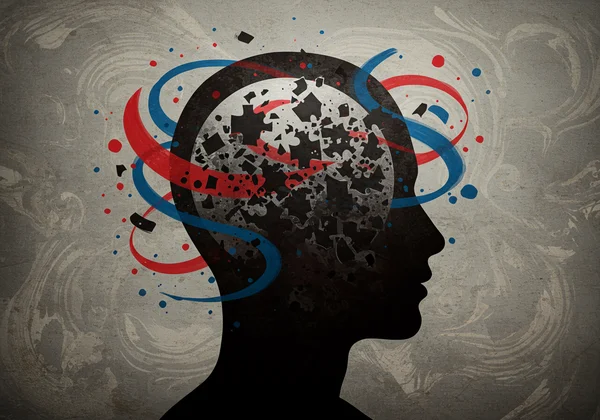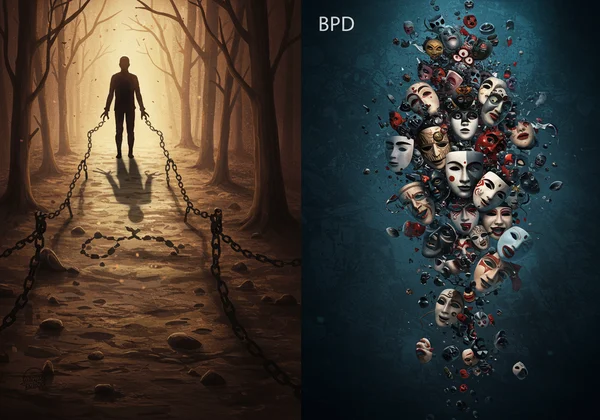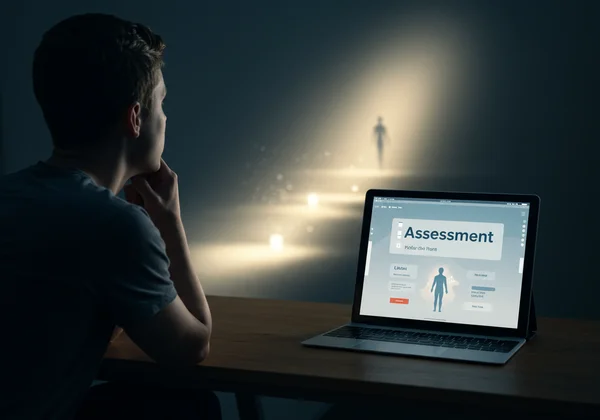CPTSD vs. BPD Test: Key Differences & Overlaps
Feeling confused by complex symptoms? You're not alone. Many people struggle to differentiate between Complex PTSD (CPTSD) and Borderline Personality Disorder (BPD) due to their overlapping signs. Is CPTSD just borderline? This guide will help you understand the nuances, offering clarity and validation for your experiences. Understanding these distinctions is a vital step on your journey toward healing, and a cptsd test can be a helpful starting point to gain initial insights.
Understanding Complex PTSD (CPTSD): Beyond Standard Trauma
Complex Post-Traumatic Stress Disorder (CPTSD) is a condition that arises from prolonged, repeated, or chronic trauma, often in contexts where escape was difficult or impossible. Unlike traditional PTSD, which typically stems from a single traumatic event, complex ptsd test often involves relational trauma experienced over months or years.
What is Complex PTSD? Defining DSO
CPTSD is recognized by the World Health Organization's (WHO) ICD-11, where it's characterized by the core symptoms of PTSD (re-experiencing, avoidance, and sense of threat) alongside significant "Disturbances in Self-Organization" (DSO). Defining DSO is crucial to understanding CPTSD. DSO manifests as:
- Affective Dysregulation: Difficulty managing emotions, leading to intense mood swings, emotional numbness, or explosive outbursts.
- Negative Self-Perception: Deep-seated feelings of shame, guilt, worthlessness, or believing oneself to be inherently flawed.
- Relationship Difficulties: Challenges forming and maintaining relationships, including avoidance of intimacy, difficulty trusting others, or feeling isolated.
These disturbances reflect the profound impact chronic trauma has on a person's identity and their ability to navigate the world.

The Roots of CPTSD: Chronic Relational Trauma
The distinguishing factor for CPTSD often lies in the roots of CPTSD: its origin. It typically develops from prolonged and inescapable exposure to adverse experiences, such as:
- Childhood abuse or neglect (physical, emotional, sexual)
- Long-term domestic violence or intimate partner abuse
- Slavery or concentration camp experiences
- Repeated bullying or systemic discrimination
These experiences, particularly during formative years, fundamentally alter an individual's sense of self, others, and the world, leading to profound and pervasive difficulties that go beyond standard trauma responses.
What is Borderline Personality Disorder (BPD)? Key Characteristics
Borderline Personality Disorder (BPD) is a mental health condition characterized by pervasive instability in moods, interpersonal relationships, self-image, and behavior. While often misunderstood, BPD involves intense emotional swings and impulsive actions.
Diagnostic Criteria for BPD: A Closer Look
The diagnostic criteria for BPD, as outlined in the DSM-5 (Diagnostic and Statistical Manual of Mental Disorders), include:
- Frantic efforts to avoid real or imagined abandonment.
- A pattern of unstable and intense interpersonal relationships characterized by alternating between extremes of idealization and devaluation.
- Identity disturbance: persistently unstable self-image or sense of self.
- Impulsivity in at least two areas that are potentially self-damaging (e.g., spending, sex, substance abuse, reckless driving, binge eating).
- Recurrent suicidal behavior, gestures, or threats, or self-mutilating behavior.
- Affective instability due to a marked reactivity of mood (e.g., intense episodic dysphoria, irritability, or anxiety usually lasting a few hours and only rarely more than a few days).
- Chronic feelings of emptiness.
- Inappropriate, intense anger or difficulty controlling anger.
- Transient, stress-related paranoid ideation or severe dissociative symptoms.
Remember, BPD symptoms manifest uniquely in each person; their intensity and combination can vary widely.
How BPD Impacts Relationships and Self-Image
For individuals with BPD, relationships can feel like a rollercoaster. The impacts relationships and self-image are profound. They may idealize someone quickly, forming intense bonds, only to rapidly devalue them at the slightest perceived slight or fear of abandonment. This can lead to a cycle of unstable relationships.
Their self-image can also be highly unstable, shifting dramatically from feeling confident and capable to utterly worthless or empty within a short period. This constant internal turmoil and fear of abandonment underpin many of their challenges.

CPTSD vs. BPD: Unpacking the Distinct Differences
While CPTSD and BPD share common ground, particularly in areas like emotional dysregulation and relationship difficulties, their underlying origins and the specific nature of their symptoms often differ significantly. This is where a nuanced understanding is key to truly differentiate cptsd bpd.
Origin Stories: Trauma vs. Developmental Vulnerabilities
One of the most defining distinctions lies in their origin stories. CPTSD is fundamentally rooted in prolonged, inescapable chronic relational trauma. It's a trauma-response disorder. The symptoms, including DSO, are seen as adaptations to a chronically threatening environment, impacting self-perception and relationships as a direct consequence of that trauma.
BPD, while often associated with adverse childhood experiences (and many individuals with BPD have experienced trauma), is viewed as a personality disorder involving a complex interplay of genetic predispositions, neurobiological factors, and environmental stressors. While trauma can be a contributing factor, it's not considered the sole or defining cause in the same way it is for CPTSD.

Emotional Dysregulation: Similarities and Subtle Shades of Difference
Both conditions feature significant emotional dysregulation, but the nature of it can vary. In CPTSD, emotional swings often relate to flashbacks, triggers, or deep-seated shame. The "freeze" response in CPTSD might lead to emotional numbing or dissociation. The anger might be a response to perceived threats or past injustices.
In BPD, emotional reactivity is often intense and rapid, sometimes linked to fears of abandonment or perceived rejection. The emotional shifts can be more volatile and less directly tied to external triggers in the same way that a CPTSD flashback might be. It’s more about a baseline difficulty regulating emotional states.
Self-Perception: Shame, Emptiness, and Identity
The core issues around self-perception also present subtle yet important differences. For those with CPTSD, the dominant theme is often profound shame. They may feel inherently bad, flawed, or "broken" due to the trauma they endured, often internalizing the abuser's narrative. This can lead to self-blame and a deep sense of worthlessness.
Individuals with BPD, on the other hand, often grapple with chronic feelings of emptiness and an unstable sense of identity. They may struggle to define who they are, their values, or their goals, leading to frequent shifts in interests, relationships, and life paths. This feeling of emptiness can be intensely painful and lead to impulsive behaviors in an attempt to fill the void.
Relationship Patterns: Fear of Abandonment vs. Difficulty with Intimacy
Relationship patterns are a critical area of overlap and distinction. Both conditions can make intimate relationships challenging. In BPD, the intense fear of abandonment is a central characteristic. This fear can drive frantic efforts to keep people close, alternating with pushing them away, creating chaotic relationship dynamics.
For CPTSD, the challenge often manifests as a difficulty with intimacy. Due to past relational trauma, individuals may struggle with trust, have a deep fear of being exploited or hurt, or feel unworthy of love. This can lead to avoidance of close relationships or a tendency to maintain emotional distance even within committed partnerships. While they may fear abandonment, it's often secondary to a fundamental inability to feel safe or truly connect.
Why Accurate Understanding Matters: Towards Healing
Gaining an accurate understanding of your symptoms, whether they point to CPTSD, BPD, or something else, is crucial for effective healing. When we understand what we're facing, we can seek the right support and strategies.
Misdiagnosis: Common Pitfalls and Why They Occur
Unfortunately, misdiagnosis can occur because of the symptom overlap. Someone with CPTSD might be misdiagnosed with BPD due to shared features like emotional dysregulation or relationship difficulties. This is especially true if the clinician isn't thoroughly exploring the history of chronic relational trauma. Similarly, individuals with BPD might have their trauma history overlooked if the focus is solely on their emotional instability.
Understanding the distinct origins and nuances, as discussed, helps prevent these pitfalls and ensures you receive care tailored to your specific needs. If you're exploring the question of whether you have BPD or CPTSD, a comprehensive understanding is your ally.
The Path Forward: Seeking Clarity and Support
The good news is that both CPTSD and BPD are treatable conditions. The path forward begins with self-awareness. Taking the time to reflect on your experiences and symptoms is invaluable. While this article provides information, it's essential to remember that it is not a diagnostic tool.
For a preliminary understanding based on scientific standards like the ICD-11 and ITQ, consider taking a free and confidential online screening. This can provide a valuable first step in your self-exploration journey and help you articulate your experiences more clearly to a professional.

Finding Clarity on Your Journey with CPTSD or BPD
Distinguishing between CPTSD and BPD can be complex, but it's a vital step in understanding your experiences and finding the right path toward healing. Remember, both conditions stem from deep pain, and both deserve compassionate, informed support. Your journey toward self-understanding and well-being is a brave one.
If you suspect you might be experiencing symptoms of CPTSD or BPD, understanding the nuances is your first step toward healing. Our free, confidential CPTSD test is designed to provide you with a preliminary assessment based on scientific standards, offering valuable insights into your experiences. Take the free test now. Remember, this cptsd test is a starting point, not a diagnosis. Always consult with a qualified mental health professional for personalized guidance.
Frequently Asked Questions About CPTSD and BPD
Is CPTSD just another term for borderline personality disorder?
No, they are distinct conditions. While they share some overlapping symptoms, particularly in emotional dysregulation and relationship difficulties, their underlying causes and the nature of their core struggles differ. CPTSD is rooted in prolonged trauma, while BPD is a personality disorder with a broader range of contributing factors, though trauma can be one.
Can I have both CPTSD and BPD?
Yes, it is possible to have both CPTSD and BPD (comorbidity). Research suggests a significant overlap, meaning an individual might meet the diagnostic criteria for both conditions. When this occurs, treatment often needs to address the complexities of both disorders simultaneously. Understanding this possibility highlights the importance of thorough assessment.
How can a self-assessment help differentiate between BPD and CPTSD?
A self-assessment like the free and confidential cptsd self-assessment available on our platform can help you explore your symptoms in relation to established criteria (like ICD-11 and ITQ). It can provide a preliminary indication of whether your experiences align more closely with CPTSD symptoms. This can be a valuable tool for self-reflection and preparing for a discussion with a mental health professional.
What is the main difference in treatment for CPTSD vs. BPD?
Treatment for CPTSD often prioritizes trauma processing therapies (like EMDR or IFS) after establishing safety and stabilization, focusing on integrating traumatic memories and healing shame. BPD treatment, such as Dialectical Behavior Therapy (DBT), focuses heavily on emotional regulation skills, distress tolerance, interpersonal effectiveness, and mindfulness to manage intense emotions and impulsive behaviors. A nuanced diagnosis helps tailor the most effective therapeutic approach.